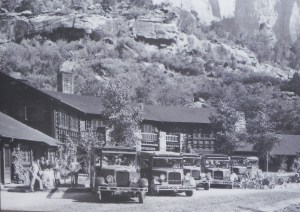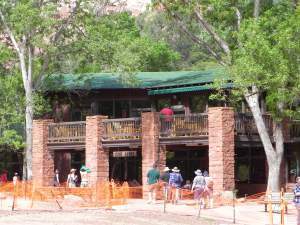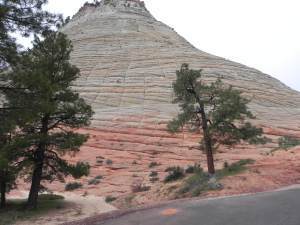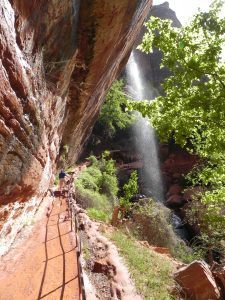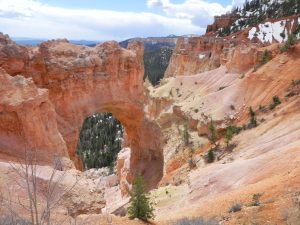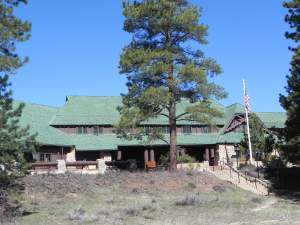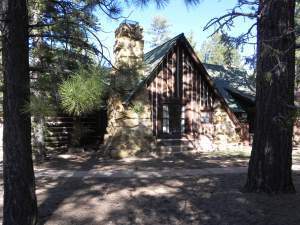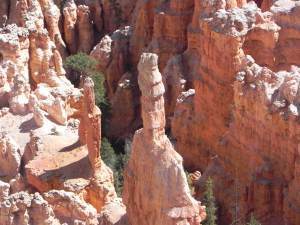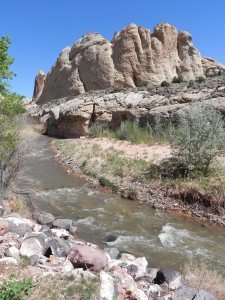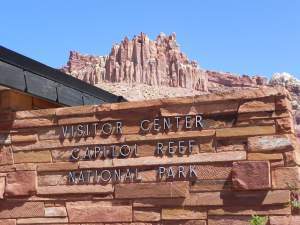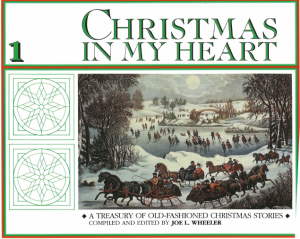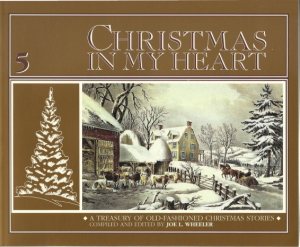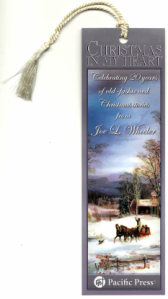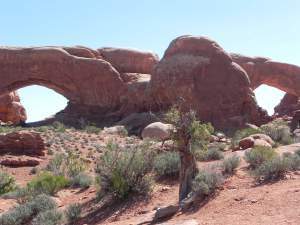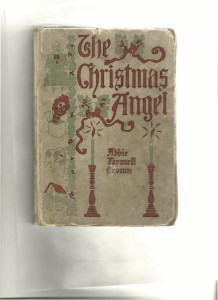Joe L. Wheeler's Blog, page 21
January 25, 2012
DR. JOE'S BOOK OF THE MONTH CLUB/ HENRY DAVID THOREAU'S WALDEN
WEDNESDAYS WITH DR. JOE
DR. JOE'S BOOK OF THE MONTH CLUB
HENRY DAVID THOREAU'S WALDEN
January 25, 2012
BOOK CLUB RECAP
Several have written in asking me about my expectations for these monthly Book Club-related blogs. To be candid, earlier on I concluded that there'd be a lot more enthusiasm on my part if I avoided nailing down a rigid template, but rather float out books I personally feel will enrich the lives of all those who read them (including myself). And let our partners in this venture have a significant part in the hammering out of a book club template. It's always more fun to be part of an experiment rather than something that's both pre-digested and pre-formulated.
As you know, I strongly encouraged–make that urged—participants to religiously keep a journal, for if they fail to do so, they'll fail to get much out of their book-readings. If you didn't read the blog on journaling, please do so today, if at all possible.
Here is the history of our Book Club blogs so far:
1. "Williamsons and Travel" October 19, 2011
Book #1 – C. M. and A. M. Williamson's My Friend the Chauffeur
2. "Dr. Joe's Book of the Month Club" October 26, 2011
3. "Journaling and Our Book Club" November 2, 2011
4. Book #2 – Abbie Farwell Brown's The Christmas Angel.
Book #3 – Charles Dickens' Christmas Carol.
Though Brown's little book was the month's selection, I urged all book club members who had never read Dickens' great classic to do so as a companion piece to Christmas Angel.
5. Book #4 – "Joe Wheeler's Christmas in My Heart Turns Twenty" December 7, 2011
Though this wasn't the monthly selection, since I devoted a blog to it, let's include it as a book club selection.
6. Book #5 – Zane Grey's Heritage of the Desert December 28, 2011
So to sum up 2011, here is what we have:
1. November's book: Williamson's My Friend the Chauffeur
2. December's book: Brown's The Christmas Angel
3. January 2012′s book: Zane Grey's The Heritage of the Desert
And strongly suggested are:
4. Dickens' Christmas Carol
5. Wheeler's Christmas in My Heart 20
If you haven't read all five, it would bring you up to speed if you caught up now as we move ahead with 2012′s books.
COMMUNICATION WITH ME
As you may strongly suspect, if you read my "Message in a Book" in Christmas in My Heart 20, I love paper and ink far more than I do digital imagery. Furthermore, my lovely wife Connie (the computer fluent of the two of us) is already overloaded/overburdened with keeping up with the multitudinous Internet communiques, queries, and orders that daily flood in; consequently, I must not overburden her by piling on her shoulders all these book club responses. So this is what we'd appreciate all book club members doing: write or type responses, queries, etc; along with photocopy journal entries you'd like me to read and respond to—and snail-mail all these to me:
Dr. Joe L. Wheeler
P.O. Box 1246
Conifer, CO 80433
and inside each mailer, indicate at the top that you are one of our book club members, being sure to include your mailing address, and indicate if you desire a personal response from me. Only for such communiques will I make up a file-folder and archive them in my filing system.
RATIONALE FOR SELECTIONS
You will find my selection-choices to defy stereotypes, for though I have earned masters degrees in history (Pacific Union College) and English (Sacramento State University) and the Ph. D. in English—History of Ideas concentration (Vanderbilt University), my monthly selections will not be arbitrarily chosen from the ranks of classics sanctified by time and erudite scholars but rather will be much more eclectically chosen, in harmony with a statement I often make to media interviewers: "There are no great authors, there are only great stories" [or, by extension, "great books"]. Reason being: no author ever hits them all out of the park. And even someone who has never shared a piece of writing outside his/her immediate family may be capable of writing a book worthy of enduring for generations yet to come. This is why you will find my choices to be drawn from a much wider pool than is normally true of book clubs.
FEBRUARY'S SELECTION: THOREAU'S WALDEN


In literary history, there are very few writers society considers so significant that they can be referenced by their last names alone. Thoreau is one of those unique writers, for he is not only significant to the literati, he is also iconic to society at large.
Henry David Thoreau (1817 – 1862) lived less than 45 years, and was born and died in the same town, Concord, Massachusetts. During his short life, he traveled little (once to Canada, once to the West, explored a few rivers, and graduated from Harvard). As a boy, he daily drove his mother's cow to pastures; in the process he became enamored of nature and solitude. As an adult, he dabbled in a number of vocations: teaching, lecturing, farming, writing, and surveying.
The best study of his life I have ever come across was written by Darrel Abel in his definitive American Literature series, published by Barron's Educational Series, Inc., in 1963. Following are some of his nuggets, which I have bullet-pointed:
Thoreau put into practice what Emerson theorized about Transcendentalism in Nature (1836).
Thoreau fell in love with Ellen Sewell, who rejected him. To compensate, he immersed himself in nature, which led to increasing detachment from humanity.
Unlike Bronson Alcott, Thoreau refused to join Transcendental communes such as Brook Farm.
Thoreau quickly abandoned his attempt to make it as a writer in New York, declaring that there were "no real living persons" there.
In 1844, he began his famous two-year sojourn in a cabin he had built with his own hands in a clearing on Walden Pond (owned by his friend, mentor, and colleague Emerson); here he was determined to find both a more natural and spontaneous mode of living and how he might best spend his life. Here he sojourned, not as a hermit, but as one who used the hut as a camp where he might interrelate with friends. Two years later, he left it because, in his words, "I had several more lives to live."
Here it was that he wrote Civil Disobedience (1849), generally considered to be the greatest American essay ever written. In it, he placed individual conscience above state institutions, and noted that "That government is best which governs least." The essay has had a world-wide impact, even Gandhi and Martin Luther King, Jr., using it as a bible for nonviolent protests.
In his first book, A Week on the Concord and Merrimack Rivers (1849), he postulated that one should live through the visible to the invisible, and through the temporal to the eternal. Thoreau was fascinated by the sacred books of the East.
But unquestionably, Thoreau's masterpiece was Walden (1854), in which he explores themes such as mankind ought to lead sincere joyous lives rather than toiling through a sham existence, featuring such immortal lines as "A man is rich in proportion to the things he can afford to let alone"; "Our life is frittered away by detail…. Simplify, simplify"; "What is man but a mass of thawing clay?"; "As if you could kill time without injuring eternity"; and "The mass of men lead lives of quiet desperation"; Walden is, without question, one of the most quotable books in all American literature.
As the years passed, Thoreau dreaded having the scientist in him displace the poet, for he was at heart a naturalist. In fact, his untimely death was caused by his lying down in the snow on top of his favorite mountain, Monadnock, in order to count the rings of a felled hickory. From that experience, he contracted consumption [tuberculosis], which proved fatal.
During the last decade of his life, Thoreau, as an Abolitionist, manned an Underground Railway station, enabling slaves to flee to refuge in Canada.
Britannica editors note that "he came to know beasts, birds and fishes with an intimacy more extraordinary than was the case with St. Francis of Assisi: "Birds came at his call, and forgot their hereditary fear of man; beasts lipped and caressed him; the very fish in lake and stream would glide, unfearful, between his hands." Another of Thoreau's memorable quotations is, "Who hears the fishes when they cry?"
* * *
Emerson, perhaps his closest friend, said of Thoreau's passing, "The country knows not yet how great a son it has lost."
* * * * *
Many a time have I taken college students to the still serene Walden Pond and the reconstructed hut that serves as a magnet attracting pilgrims from around the world, more than a few dressed in eastern garb, carrying banners, and beating drums.
Quite simply, Walden (available everywhere), though short, is one of those few books that are so seminal it is unthinkable to pass through this journey we call life without experiencing it at least once. A warning, though: Be prepared to fill many pages of your journal with lines that will deeply resonate in your mind.








January 18, 2012
ZION NATIONAL PARK
WEDNESDAYS WITH DR. JOE
SOUTHWEST NATIONAL PARKS #6
ZION NATIONAL PARK
January 18, 2012
For millennia, it was one of the earth's loneliest places, known only to aboriginal Native Americans such as the Virgin Anasazi (arriving here in the 1200s), followed by the Paiutes [meaning "Utes who live by water]. A Mormon pioneer named Nephi Johnson is reputed to be the first individual of European ancestry to set eyes on the canyon, in 1858. Isaac Behunin, another Mormon settler, in the 1860s, was so awestruck by the magnificent scenery of the canyon that he proclaimed, "This is Zion!" Brigham Young himself packed into the canyon in 1863. Famed explorer John Wesley Powell, hearing of the area's wonders, trekked in sometime in 1872.
Even so, the canyon remained virtually unknown to the outside world until Scribner's Magazine featured it in a 1904 article. At that time, although there was a lot of national buzz generated by the new Fred Harvey hotel, El Tovar on the Grand Canyon's South Rim, there was virtually nothing known about any of the many national wonders north of the Grand Canyon we take for granted a century later.
In 1917, National Park Acting Director, Horace Albright, accepted an invitation to visit Southern Utah, where the Virgin River carves its way through a beautiful canyon of sandstone cliffs. It had been set aside as a National Monument in 1909—named Mukuntuweap, from a Paiute word for "canyon"—but had been virtually ignored by the federal government ever since:
I was surprised, excited, and thrilled. More than that, I was just plain stunned. I had no concept of the staggering beauty I beheld. Local Utah people said that Yosemite was a [Mukuntuweap] without color. But this didn't faintly prepare me for the reality of the towering rock walls, splashed with brilliant hues of tans and reds interspersed with whites.
The great towers, temples, spires, and peaks appeared unearthly as they encircled the narrow, lush gorge cut by the sparkling Virgin River.
It was love at first sight for me. I was so impressed . . . that I determined we should expand Mukuntuweap and have it made a national park.
Albright's enthusiasm, upon his return to Washington, took him to the White House where he convinced President Woodrow Wilson to change the monument's difficult-to-pronounce name to the name Local Mormons had long used for the canyon, "Zion." Within a year, Congress would follow Wilson's lead, expand the protected area to 147 ,551 acres and elevate its status to Zion National Park (Duncan and Burns, 171).
But even national park status failed to significantly increase tourist traffic into the park, mainly because it was so difficult to get to. Horace Albright and Stephen Mather, to remedy this situation, in 1922, persuaded the executives of Union Pacific Railroad to join forces with the National Park Service and construct spur lines into the park's vicinity and create a lodge worthy of its setting. In May of 1923, architect Gilbert Stanley Underwood was summoned to Union Pacific's headquarters in Lincoln, Nebraska and invited to add Zion to his portfolio, along with Bryce.
It is interesting to note the pattern that developed over the years of Underwood's long and distinguished architectural career with the National Park Service: the rustic lodges would be secondary to the landscape itself—lying gently on the land. His earlier ones tended to simplicity, but as the years passed, Underwood's vision for the lodges grew grander.
In Zion, Underwood constructed a two-story wood, stone, and glass edifice, anchored by four large native sandstone columns. By 1927, he had flanked the hotel by ten duplex Deluxe Cabins; and by 1929, five fourplex Deluxe Cabins. Those Deluxe Cabins were as beautiful and enduring as the Bryce Canyon cabins descried in our January 11 blog: characterized by native stone fireplaces, chimneys, foundations, exposed mill framing, gable roofs, and front porches.
At the same time, Mather and Albright helped push through an engineering marvel: the 10-mile-long Mt. Carmel-Zion Scenic highway [Highway 9]; the 1.1 mile tunnel, blasted through solid rock, took almost three years to complete. Before the highway was opened in 1930, fewer than 4,000 visitors a year made it into the park; the year it opened, that number swelled to 55,000.
Sadly, on January 28, 1966, Underwood's lovely lodge burned down, accidentally ignited by a crew doing repair work. All that was left were the stone fireplace and the four pillars. It was rebuilt in 108 days—but gone forever was the charming original. Trying to be kind, Barnes characterizes the result as "a simple two-story utilitarian building with little appeal and none of the design and planning that went into earlier park architecture" (Barnes, 119). Others were more frank, labeling ti a "monstrosity." Through the years since then, however, beginning in 1992, current ownership (XANTERRA Parks and Resorts [formerly Fred Harvey Hotels]), began a program of restoration and has tried to bring back some of the ambiance of the original. But to anyone who has studied photographs of the original, what exists today jars and elicits a longing for what once was.
Park-wise, however, good things continue to happen. Over 2,500,000 visitors come here every year, from all over the world. Since the valley was being destroyed by congestion, beginning in 2000, the heart and soul of Zion (the valley floor), has been closed to auto traffic during tourist season. Instead, visitors park in Springdale and board propane-powered shuttle busses that ferry visitors into and out of the park. The only exceptions have to do with those lucky few who have secured lodging inside the park at the lodge. Their orange window cards enable them to drive to the lodge and park there until check-out time, when they may drive out. Exceptions are dealt with by park police. This has restored serenity to Zion.
OUR OWN JOURNEY
Awoke at 5:35 so as to get dressed and take in sunrise over Bryce Canyon. We (Bob and Lucy Earp, and us) were disappointed as the overcast sky kept the sun from doing its usual colorizing. After a delicious breakfast in the lodge dining room, we dithered as long as we could, furious at ourselves for failure to book two nights in that already cherished Duplex Cabin. After checking out, we spent several hours driving along the rim, stopping at overlooks, then proceeding to Rainbow Overlook (the highest part of the park). By then, the sun had broken through the clouds.
All too soon, we headed for the exit and then south on #89 through Glendale, Orderville, and Mount Carmel, to Mount Carmel Junction; here we turned west on #9 on the Mount Carmel-
Zion Scenic Highway. That famed tunnel continues to amaze, even over eighty years after it was bored through solid rock. The occasional panoramic windows provide us with glimpses of the magical world outside.
Once we came out into the sunlight, we were free to leatherneck—unfortunately, the Lincoln had no sunroof. Finally, we turned in at the Zion National Park Visitor Center in Springdale. It was a warm May day—but not nearly as warm as it gets in July (100E the daily average)! We took full advantage of the film on the park's history and iconic landmarks (such as the Weeping rock, Angel's Landing, Kolob Arch, Temple of Sinawava, Great White Throne, the Organ, the Narrows, the Watchman, Towers of the Virgin, Kolob Canyon, Court of the Patriarchs, Checkerboard Mesa, etc).
Then we got back in our car, and made it past security, thanks to our orange card prominently marked (Registered Zion Lodge Guest), with dates. We really felt privileged as we were permitted to drive in to the lodge.
The lodge was, as we knew it would be, a disappointment, after Bryce. Besides, the area around it is roped off because of a habitat restoration project. The wooden motel-like structure which housed our rooms was "same ol same ol," typical of other forgettable lodgings we have stayed at through the years. Dinner, we ate at the lodge's salad bar. After playing dominoes, we turned in.
J97 – Waterfall in one of the side canyons
Next morning, we awoke to a stunning blue sky day! Breakfast was delicious. We spent the day exploring the sites of the canyon, including side canyons, the Weeping Rock, along the Virgin River, and ending the day walking up into the Narrows where the Virgin River pours out of a slot canyon. Along the way, we rubbed shoulders with men, women, and children, of all ages and nationalities. Cooler than the day before, it turned out to be one of those absolutely perfect May days that come to us all too rarely in this journey called "life."
Most visitors see only a small portion of the park, restricting their travel to the 6.2 mile road on the valley floor and possibly the Mt. Carmel-Zion Scenic Highway, and completely missing the spectacular northwestern end of the park, the Kolob Canyon area, which includes Kolob Arch, at 310 feet across possibly the largest free-standing rock arch in the world, and the steep 20-mile-long Kolob Terrace Road, out of the town of Virgin. Neither did we make it to that part of the park; we could only sigh once again, and with Lucy, intone "A blessing for another time."
SOURCES
Barnes, Christine, Great Lodges of the National Parks I (Bend, OR: W. W. West, Inc., 2002).
Colorado and Utah (Heathrow, FL: AAA Publishing, 2010).
Duncan, Dayton and Ken Burns, The National Parks: America's Best Idea (New York: Alfred Knopf/Random House, 2009).
Leach, Nicky, Zion: Sanctuary in the Desert (Mariposa, CA: Sierra Press, 2000, 2010).
The Most Scenic Drives in America (Pleasantville, NY: Reader's Digest, Inc., 1997).
Scott, David L. and Kay W., The Complete Guide to the National Park Lodges (Guilford, CT: Globe Pequot Press, 1998, 2009).
White, Mel, Complete National Parks of the United States (Washington, D.C., National Geographic Society, 2009).








January 11, 2012
BRYCE CANYON NATIONAL PARK
WEDNESDAYS WITH DR. JOE
SOUTHWEST NATIONAL PARKS #5
BRYCE CANYON NATIONAL PARK
January 11, 2012
THE ESCALANTE
Though millions of tourists throng Utah's national parks, few are aware that most of them are part of a colossal geological formation Spanish explorers dubbed "The Escalante" (named after Spanish explorer Francisco Escalante), or "the Giant Staircase." The Escalante reaches into Capitol Reefs National Park to the northeast and Cedar Breaks National Monument to the northwest (reaching a height of over 10,000 feet). Bryce varies several thousand feet in elevation (6,600 to 9,120); Zion (to the south) ranges from 3,666 to 8,726 feet in elevation. East is the Grand Staircase Escalante National Monument (a vast 1.9 million acre preserve established by presidential proclamation in 1996). The Escalante descends via Glen Canyon south to the Colorado River floor of the Grand Canyon (the lowest step). Its two great river systems are the Paria and Escalante. This area is without doubt one of the most remote regions in the lower 48.
BRYCE CANYON
"It's a hell of a place to lose a cow."
–Ebenezer Bryce
Ebenezer Bryce, a Mormon pioneer, moved with wife and family to this then remote region in 1875. Other Mormon settlers, since the then all but unknown canyon represented the Bryce family's back yard, so to speak, dubbed it "Bryce's Canyon." In 1916, Ruby and Minnie Syrett decided to homestead in the area. As word of the canyon's unique beauty got out, tourists started packing in. The Syretts concluded that there was a living to be made here, so set up tents, fed meals to the visitors, and eventually built a rather primitive lodging they called "Tourists' Rest." In 1918, the Salt Lake City Tribune wrote of the canyon in glowing terms, declaring it to be "Utah's New Wonderland."
In the fall of 1918, just after World War I ended, Stephen Mather (founder of our National Park system), came to southern Utah to see for himself some of the wonders he'd been hearing about. When he reached Bryce, a guide told him to close his eyes, led him to the very edge of the abyss, then told him to open his eyes. When he did, he was so stunned by what he saw that he responded by saying, "Marvelous!" "Exquisite!" "Nothing like it anywhere!" (Burns and Duncan, p. 174). He determined to preserve it at all costs for the American people. In this, he was ably supported by Utah Senator Reed Smoot. In 1923, President Harding proclaimed it a National Monument; in 1928, doubled in size, Congress created Bryce National Park.
It is considered to be among the most spectacular and rewarding of all America's national parks: "The spectacle of Bryce Canyon unfolds from the rim, a panorama of pink, purple, orange, and white limestone figures creating visions of oversized gargoyles, spires, temples, and arches set in gigantic scoops that span miles and drop 1,000 feet below. . . . At Zion you look up, at Bryce you look down." (Barnes, p. 127).
Because of extreme temperature fluctuation and seasonal rainfall, Bryce's topography is continually changing. These often bizarre-looking rock pillars, pedestals, and toadstool forms are collectively known as hoodoos. And they are what makes Bryce so unique.
There are three very different ecological zones: highest, where spruce-fir predominate; middle, ponderosa pine stands; and lowest, with piñon pine and aspens. It encompasses 35,835 acres (56 square miles).
BRYCE CANYON LODGE
According to Christine Barnes, both Stephen Mather and his associate, Horace Albright were determined to have constructed lodges and hotels worthy of their settings. Especially were they set on choosing only the best architects to design them. For Bryce, renowned architect Gilbert Stanley Underwood was chosen for the job. Underwood first visited Bryce in 1923. Since he was not permitted to build it on the rim itself, he positioned it in a grove of ponderosa pines just a short walking distance from two of the canyon's most spectacular overlooks. Since tourism was crucial for park success, Mather persuaded Union Pacific Railroad's management to partner with the Park Service.
Underwood had the needed stone cut at a quarry only a mile and a half away; the timber was local as well. Even the workers were local. From all indications, it appears that the lodge was intended to be only temporary, to be replaced with a better one later on. Rather than using great logs such as were used in other lodges, 20-inch-logs were hauled in. The original portion of the lodge was completed in 1925.
Adjacent to the lodge, Underwood completed a complex of 67 wood-frame cabins by 1927. By 1929, Underwood completed fifteen Deluxe Cabins. Given that the Great Depression of the 1930s followed that year, Underwood was never permitted to build a more substantial lodge. Because of this, these Deluxe Cabins, with their steeply-pitched gable roofs, stone foundations and chimneys, big front porches, and half-log-slab exterior walls, are all that remain of the architect's original template for Bryce. Architecture historians today consider these cabins to be among the finest examples of historic rustic architecture to survive down to our time.
As was true of so many sister lodges, Bryce Canyon Lodge and cabins have had it anything but easy during the last almost ninety years. During World War II, the lodge was closed completely for two years. Union Pacific Railroad discontinued summer train service during the 1960s. But the post-war boom brought in so many tourists that the lodging facilities were strained to the limit. In 1986, a serious restoration program was begun. In the process, they discovered the lodge's foundation was virtually nonexistent. They had to construct a new one. Most everything was spruced up. In cooperation with FOREVER RESORTS, a great deal of effort and money has gone into restoring much of the lodge and cabins. So much so, that the original aura has been almost completely restored.
OUR OWN JOURNEY
At Torrey, we picked up Highway 12 going south. Before long, we began to climb – and climb, up 9,620 feet Boulder Mountain. Off to the east jutting into the sky were the snow-capped Henry Mountains. We passed the road that led to the spot where a number of years ago, traveling solo, I'd camped out for the night in my sleeping bag. A tiny piece of my life left in that grove of trees.
After reaching the summit, we descended toward Escalante. Another memory awaited there. Even though I am not paranoid about heights, ahead was a stretch of Highway 12 that gave me the heeby-jeebies the first time I drove over it—would it be less formidable this time? Vain hope! Like many of you who love to travel, I'm a veteran of terrifying roads: the old Tioga Pass Road out of Yosemite still comes to me in my dreams sometimes. But on Tioga, even though you were only one loose lug-nut from plunging into space, one could always fudge into the inside lane. Not so the Escalante stretch: the most apt metaphor I can think of is, it's like driving on a razor blade, with a sheer drop to the right of you and a sheer drop to the left of you. Grand Staircase without railings! I noticed that it was mighty quiet in the car; not until we reached tierra firme again did natural breathing resume.
It was mid afternoon when we turned left towards Bryce Canyon. At the village, there were quite a number of restaurants and lodging options; necessary, because reservations in the park itself are limited to Bryce Canyon Lodge. Other travelers are encouraged to leave their cars outside the park and take the shuttle in, for parking spaces in the park are scarce.
We thought we'd learned our lesson the year before when we took the Northwest National Park Loop: stay two nights at each lodge rather than one. Generally speaking, we'd done that. But not at Bryce. After all, it was a relatively small park. BIG MISTAKE!
We pulled in at the lodge and checked in. The lodge itself was western rustic, simple, blending into the ponderosa grove. Then we found our way to the Deluxe Duplex Cabin (units 538 and 539) that we'd reserved over a year before. It was an architectural thing of beauty! Both outside and in! The soughing of the pines and the somewhat isolated placement of our cabin combined to strip us of all the pressures of the world. Making the experience even more meaningful was the realization that well over eighty years ago, architect Gilbert Stanley Underwood, National Park visionaries Stephen Mather and Horace Albright, and executives of Union Pacific Railroad had all studied and fine-tuned the creation of this very cabin! Then, the icing on the cake: a knock on the door. A welcome basket from the high command of FOREVER RESORTS, cherished friends of ours. And just think: we'd have to leave this heaven-on-earth in the morning!
It almost took crowbars to pry us from our cabin! For after all, we'd come here to see the canyon, not the lodging. It was mid-afternoon, yet the canyon still overwhelmed. Down below we could see hikers descending into the goblinland of the hoodoos; and other hikers were emerging from them on the way back up.
After a while we returned to the cabin as we had made early dinner reservations in the lodge's dining room. Delicious quesadilla! Afterwards, almost too late, we raced back to the rim and mistakenly went to Sunrise Point first instead of Sunset Point. The colors, though stunning, were already fading and the shadows were remorselessly closing shop. Right on the edge, two engaging young women were seated on a bench overlooking the canyon, a simple dinner spread out between them. I struck up a conversation with them. Turned out they were from Germany, here on a holiday. All too soon they'd have to return home. But, they admitted, already they'd fallen in love with Utah. They'd be back!
Later on, we returned and listened to a fascinating lecture on migratory birds; unfortunately, the serenity of the place had so seeped into our bones that all we could think of was migrating back to that wonderful cabin, sitting by the fireplace, crawling into bed, and listening to the wind in the pines. So we did just that.
SOURCES
Barnes, Christine, Great Lodges of the National Parks I (Bend, OR: W. W. West, Inc, 2002).
Bezy, John, Bryce Canyon: The Story Behind the Scenery (Wickenberg, AZ: K. C. Publications, 2001).
Colorado and Utah (Heathrow, FL: AAA Publishing, 2010).
Duncan, Dayton and Ken Burns, The National Parks: America's Best Idea (New York: Alfred Knopf/Random House, 2009).
The Most Scenic Drives in America (Pleasantville, NY: Reader's Digest, Inc., 1997).
Utah's National Parks & Monuments (New York: American Park Network, 2009).
White, Mel, Complete National Parks of the United States (Washington, D.C.: National Geographic Society, 2009).








January 4, 2012
TO REACH THE PORT OF HEAVEN
WEDNESDAYS WITH DR. JOE
TO REACH THE PORT OF HEAVEN
January 4, 2012
"I find the great thing in this world is not so much where we stand, as in what direction we are moving: To reach the port of heaven we must sail sometimes with the wind and sometimes against it—but we must sail, and not drift, nor lie at anchor." —Oliver Wendell Holmes
As I write these words—yes, I still write with a Pilot V5 pen rather than type on a keyboard—and begin the third year of "Wednesdays with Dr. Joe" blogs, I am profoundly grateful.
First and foremost for the gift of life. So many of my contemporaries have written the last page of their life stories. For some reason, known only to Him, God has seen fit to extend my life beyond the biblically "three score and ten." The last time I was in the hospital for surgery, I watched with morbid fascination the digital zig-zagging on the screen that monitored my faithful aging heartbeats. Each time it descended, I found myself wondering if this would be the time it would stop and never go up again. Finally, I had to turn my eyes away; the stress was too much!
Second, for the gift of awareness. One in every five of us will die mentally before we die physically. That happened to my beloved mother. Such a phenomenal near photographic memory she had! Able to retain thousands of pages of short stories, poetry, and readings in her memory banks—then, one fateful day: the light of awareness flickered out of her eyes. When we entered her room after that and looked into her eyes—there was no one home anymore.
Third, for the gift of family. One of my cherished friends, an erstwhile millionaire, lost everything (job, house, bank account, solvency) in this recession. When I asked him how he was coping, there was a long pause before he answered with, "You know, today my financial life is in shambles, I couldn't even buy a used bicycle on credit—much less a car! Belatedly, I've come to the conclusion that the only real bedrock in this unstable world is God, family,and health. I still have God, a family who loves me, and my health. I'm ever so blessed as long as I still have all three!" I too am oh so grateful I still have a wife, children, and extended family who love me more than I deserve."
Fourth, for the gift of friendship. How bleak this world would be without friends! Every Wednesday morning for over fifteen years now, I have met with Conifer Kiwanis! Even though our numbers have shrunk from what they were before the recession, we still show up each Wednesday. And each year, they grow dearer. One is so fragile with age we rarely see him—and oh! How we feel his absence each week! But I'm blessed with so many many friends. My church family, my Zane Grey's West Society family, my student/colleague family (generated during over a third of a century in the classroom), my alumni family (those who came into my life during my growing-up years), my Focus on the Family dear ones (I've shared Christmas with them in their Chapelteria and book store for sixteen years and counting), my publishing family (from twelve publishing houses) who continue to enrich my life. And last but anything but least all those thousands who have come into my life because of our 76 books and counting, blogs, media interviews (between 500 and a thousand), and tweets. One family (besides my family and agent, Greg Johnson) owns all 76 books. But I've recently become aware that I have a wonderful extended family in all those who own all 20 (or 22) Christmas in My Heart books. I call them "Christmasaholic completists." What can bring two people closer than a shared obsession? By next year, I hope to have a list of as many of them as will check in with me. I need their help as we together vote on the "20 Greatest Christmas Stories Ever Written."
Recently, someone said to me, "Have you ever wondered how many people who've read your books through the years have had one-sided conversations with you?" I'll never know the answer to that question—at least on this earth. So many times I've signed for ten to twelve hours a day—yet the Lord has miraculously saved me from carpal tunnel syndrome!
* * * * *
So, Dear Friends, whoever and wherever you might be, Connie and I are so grateful you're taking time out of your hectic weekly schedule to spend a little time with us! Let's together make 2012 "a very good year!"








December 28, 2011
ZANE GREY'S HERITAGE OF THE DESERT
WEDNESDAYS WITH DR. JOE
DR. JOE'S BOOK OF THE MONTH CLUB
ZANE GREY'S HERITAGE OF THE DESERT
Dec. 28, 2011
CLUB NEWS
Since I'm stumbling into this Book of the Month Club thing, I must confess I have no idea how many of you are actually trying to secure copies of these books and are reading them. Nor do I have any idea as to how many of you are actually reading the club-related blogs. True, I have received a number of responses — all positive so far—, but that's all I have to go on. Naturally, I'd love to hear from you.
ZANE GREY
As some of you know, I wrote my Vanderbilt doctoral dissertation on the frontier writer Zane Grey. Four years later, I began editing and publishing Zane Grey's West (it ran from 1979 – '91); in 1983, I co-founded the Zane Grey's West Society; I have continued as Executive Director ever since.
Since many of you may not be acquainted with Zane Grey, permit me to sketch out his significance:
THE TITAN
ZANE GREY
(1872 – 1939)
Zane Grey towers over the first half of the twentieth century like no other. During that period he was not only the highest-paid author in the world, he was also the top-selling author, his readership estimated to top 500,000,000. Frank Gruber feels that Grey dominated the entire twentieth century, his popularity as great overseas as in America.
He also dominated the magazine world during the Golden Age of Print. Never before (and never since) were so many great magazines all publishing at once. And should Country Gentleman, Field and Stream, Munsey's, Argosy, American, Cosmopolitan, McCall's, McClure's, Pictorial Review, Popular, Ladies' Home Journal, or Colliers be serializing a Grey novel, newsstand sales would skyrocket, hence no author was paid as much for a serial as he.
No author, before or since, has even come close to his dominance of the Silver Screen. Almost unbelievably, over 131 movies have been made from his books, and the leading actors and actresses of the age starred in them. On movie marquees (in size and lights), Grey's name far outranked those of the stars.
Two television series based on his books have been aired, one lasting six years.
He is considered to be the Father of the Western. Before him, there was not even a perception that there ever was such a period as "The Old West." And later western bards such as Louis L'Amour had to admit that Grey was the last western writer to write while the frontier still existed. Alice Payne Hackett, in her 70 Years of Best Sellers: 1895 – 1965 (Bowker, 1967), noted that, of the 25 top-selling westerns of all time, 15 of them were by Grey.
No western author is represented by so many comic book and Big Little Book titles as he.
So why has his popularity lasted for over a century now, when most of his contemporaries have long since been forgotten? Why is it that even today as many women read him as men? Perhaps because his female protagonists are even more fully realized than their male counterparts. Perhaps because to him, the settings were more important than the characters (he was the first author to insist that his books be filmed on location). Perhaps because Grey painted with descriptive words and passages in the same way that Moran or Bierstadt painted with a brush. It is these marvelous descriptive passages that elevate Grey into the pantheon of great artists. Perhaps because values worth living by were central to Grey. His tales play out on epic stages such as did the Norse heroes of the Nibelungen Lied, the Arthurian tales, Beowulf, or Shakespearean dramas such as Hamlet, Macbeth, or King Lear. Perhaps because he knew the people first-hand that he chronicled. Perhaps because Grey was at heart a naturalist, and chronicled, in his fiction and nonfiction, the wildlife he encountered. George Reiger (the dean of contemporary sports writing) maintains that Grey may someday be remembered more for his True Life outdoor adventure stories and books than for his fiction. Perhaps because the animals in his books were developed as fully as his humans (featured in masterpieces such as Don, The Wolf Tracker, Tappan's Burro, and The Thundering Herd). Perhaps because he may very well be the greatest fisherman of all time (he and his entourage capturing all but two of the deep-sea fishing records of the world). Perhaps because of his leading role in conservation, in his concern for an environment that was already vanishing. Perhaps because he was a semi-pro baseball player who could easily have walked into Cooperstown had he stayed in baseball. And last—but anything but least—perhaps because he had the wisdom to marry Lina [Dolly] Roth Grey (one of the most remarkable women of her time), and an equal player in the unparalleled success story that is Zane Grey.
By
Joe L. Wheeler, Ph.D.
©2005
THE HERITAGE OF THE DESERT
I have chosen this book as our January 2012 book of the month for a number of reasons. Before he wrote Heritage, he'd first written Betty Zane (1903), The Spirit of the Border (1906), The Last of the Plainsmen (1908), The Last Trail (1909), and The Short Stop (1909), but of them, three were eastern Ohio Valley frontier novels, one a baseball novel, and one a hybrid biography/True Life Adventure. Heritage was the first western he ever set in what we today consider to be the mythical Old West: the Southwest.
In January of 1906, Zane Grey and his bride Dolly disembarked from the train at the then new El Tovar Hotel on the South Rim of the Grand Canyon. This was their first stop on their honeymoon. When the clouds lifted that evening and the sunset transformed the abyss into an inferno, Zane and Dolly were speechless: the spectacle was too overwhelming for mere words. Grey would spend the rest of his life vainly trying to capture that scene and the West in words.
Grey returned in 1907 and 1908 to lasso mountain lions on the Grand Canyon's Kaibab Plateau with Buffalo Jones ("The Last of the Plainsmen"), but not until November of 1909 did Grey finally sit down, pencil in hand, to write his first great western, a book he hoped would have the epic scale of Wallace's Ben Hur. As Mescal (his first title) took form, he became more and more excited—the outside world, for him, all but ceased to exist. On January 22, 1910, meals were all. but forgotten as his pencil raced across the page.
Heritage was Grey's first great book. It sold well from the first and has consistently held its own through the years. August Naab was, in real life, Jim Emett, a Mormon pioneer who lived at Lee's Ferry on the Colorado River. Grey lassoed mountain lions with Emett and Buffalo Jones in 1907 and 1908. I think you will agree with me that August Naab is one of the most magnificent characters in all western literature. In the novel, Naab is portrayed as an apostle of non-violence who is gradually forced by circumstances to alter his code. The book also features a theme Grey dealt with often: Regeneration. Grey felt that the West either transforms weaklings into strong men or it destroys them. In the pages of this novel, you will experience with Grey a West that is so new to him you feel its vibrancy in every page. In fact, some critics claim the book is one-of-a-kind because never again was the West to be this fresh to him.
I don't want to deprive you of your own conclusions so I'll let you take it from here. Some questions yu may ask yourself are these: What kind of a heroine is Mescal? Is she fully developed as a character? Multidimensional? What about the element of Good Samaritanism in the novel? When Grey wrote the novel, magazines ruled supreme, and those who could write spell-binding serializations were paid extremely well. In those pre-TV days, family life centered around the fireplace, kitchen stove, or front porch. Since pictures were few, readers gravitated to writers like Grey who could paint pictures with words rather than with a brush. That way, each of them could paint pictures unique to them in their minds. I will be most interested in your reactions to this novel.
The book ought to be relatively easy to find on the web. Two sources you might check are Don Gallagher (1425 Broadway, Denver, CO 80210) and Eric Mayer's Bluebird Books (8201 S. Santa Fe Dr., #245, Littleton, CO 80120). Harpers published the First Edition; Grosset & Dunlap followed with hardback reprints which normally included four illustrations. Most other hardbacks do not feature illustrations. The same is true for the many trade paper editions. Just make certain your book is unabridged.








December 21, 2011
IOWA CAUCUS – REBIRTH? OR ABERRATION?
WEDNESDAYS WITH DR. JOE
IOWA CAUCUS
REBIRTH? OR ABERRATION?
Dec. 21, 2011
As a historian of ideas, I've always been fascinated by sudden turning points. Case in point: During the last year, we've seen, one after another, the emergence of democracy all across North Africa and the Middle East. Even totalitarian Russia now feels the open scorn of its people.
In the daily news, we've seen Europe reeling from one economic seismic shock after another. For decades, Europe has been a poster child for a template that appeared to have staying power: one currency for all, fiscal stability, no closed borders between nations, cradle to the grave welfare for all, more than generous retirement benefits, vacations galore (it often seemed that the population of the entire continent could be found on beaches every August), and millions of tourists flooding the continent the icing on the cake. But no longer: Europe's template has cracked right down the middle. And nobody knows how to fix it.
In the U.S., things are little better than in Europe. Only the fact that the spotlight of the world has been fixated on Europe rather than us has enabled us to escape the world's scrutiny. But that cannot long last. Our status quo is unrelentingly grim.
But in Iowa, on the eve of the last debate before the Caucus, something electric happened. Gingrich may well be right in declaring that we haven't had anything this substantive in our political arena since the Lincoln-Douglas debates a century and a half ago. But first, I must admit that, though I'm a registered Republican, I'm a centrist and vote accordingly. Like most Americans, in recent years I've been disillusioned time after time by the G.O.P. All too often it has seemed as if our Republican leaders were determined to out-dumb each other. ""Naive' and "uninformed" way too inadequate to describe their condition, their evident ignorance of current events and national and world history off the charts of probability; their voting out of offices the informed and intelligent moderates who would work together for the good of the country – instead they elected, all too often, individuals so close-minded they'd stampede the nation off a cliff rather than work together.
However, on Dec. 15, there took place a rational debate between presidential candidates who, for once, did themselves and their party proud. Same for the moderators. Such an impact did this make on me that I was unable to sleep afterwards; in fact, at 2:30 a.m. next morning, I got up and wrote until 5:00 a.m.
But even now, I find myself incapable of really making sense of all I heard that night. I'm mightily muddled. But even so, permit me to muddle through these swirling unconnected thoughts. Stream-of-consciousness disorganized because I can't yet make sense of them:
It's like, on the eve of Dec. 15, the proverbial straw broke the camel's back. The candidates and the concerned audience fed on each other, together rising to unexpected heights:
Rather than merely ramble on unstructured I am bullet-pointing the concerns that generated that eve of Dec. 15:
Government gridlock
Out-of-control spending
Massive unemployment – worst since the Great Depression of the 1930s, for third year in a row
Epidemic of bankruptcies
Millions of lives shattered by foreclosures and being evicted from their homes. Almost half owe more than they could get by selling their homes.
The middle class shrinking so dramatically that the gap between rich and poor has yawned so wide we risk revolution from the disenfranchised.
The collusion between government and Big Banks
The breakdown of our protective agencies
The federal out-of-control spending taking a terrible toll on the finances, education, social programs, infrastructure, and public services of individual states, resulting in a devastating implosion
The revolving door between government and lobbyists
Government office being restricted to self-made millionaires or billionaires or those who sell their souls to special interest groups
The decline of a literate electorate. With elections decided by electronic sound-bytes rather than thoughtful reading of newspapers, magazines, and books
The political campaigns degenerating into attack ads and character assassination orchestrated by unknown sources or people
Vote fraud
The staggering economic toll taken by multiple foreign wars
Retirees losing all they'd saved for their retirement years
Graduates unable to find well-paying jobs
Manufacturing continuing to be sent overseas
The perceived failure of so many of our schools and colleges
The courts becoming ever more hostile to all public expressions of religion or belief in a higher power
Marriage discredited by secular forces; so much so that the nuclear family (man, woman, child) is for the first time ceasing to be the norm. Out-of-wedlock births are skyrocketing to such an extent that it is said that one-third of all American children are effectively being raised by their grandparents. Sexuality today trumps lifetime commitment.
A media apparently determined to so ridicule religion and those who attempt to live by biblical principles that they will discredit those people into irrelevancy.
Widespread attempts to strip religious holidays such as Christmas and Thanksgiving of their spiritual significance
The replacement of time-honored concepts of Good and Evil and Right and Wrong with psychiatric terminology divorced from a Higher Power. Result: lying under oath no longer means much to all those who don't believe in God (however they may perceive Him). Neither do cheating or stealing seem wrong.
Deconstruction of history strips our erstwhile national heroes of whatever noble qualities were once attributed to them.
Thoughtful parents so terrified of societal forces hostile to their children (bullying, hazing, pedophilia, rape, substance abuse, sexuality without commitment, ridicule of their beliefs, etc.) that they are pulling their children out of public schools and homeschooling them
CONCLUSION
All these variables swirled around during the memorable two-hour debate (meaningful because moderators asked searching thoughtful questions of the candidates, zeroing in on issues where candidates were perceived to be on thin ice). Furthermore, moderators permitted candidates to respond and defend their actions and words. Unlike so many meaningless public debates of recent years, where no real substantive dialogue took place, this debate was very real—indeed it was so gripping I felt it to be high drama!
Significantly, the Dec. 15 growing consensus appeared to be: our template is broken beyond repair; it almost has to be rebuilt from the ground up, starting with cutting politicians' salaries in half, moving back to citizen governance with half-time government service and half time work in the real world. Frugality once again. Pay as we go: don't spend any money we don't have. Create jobs rather than parasitically siphoning off the life blood of those who are working hard to create a newer and better society. Bring God back—, more to the point: bring us back to God. Respect right to life. Bring back a society based on the twin bedrocks of God and country.
Frankly, I'm less than optimistic that what I felt in the auditorium on Dec. 15 will blossom into a much needed cultural revolution. For both parties—not just the G.O.P.
However, in the darkest days of history, God has summoned great men and women to selfless service—Moses, Daniel, St. Paul, St. Nicholas, St. Francis, Luther, the Wesleys, Washington, Florence Nightingale, Clara Barton, Lincoln, the Roosevelts, Gandhi, Schweitzer, Churchill, Mother Teresa.
Why could not God do it again?








December 14, 2011
CAPITOL REEF NATIONAL PARK
WEDNESDAYS WITH DR. JOE
SOUTHWEST NATIONAL PARKS #4
CAPITOL REEF NATIONAL PARK
Dec. 14, 2011
In all probability, most of our readers have never even heard of Capitol Reef National Park. Where's that? you may wonder; if it's anywhere most likely it's some island park somewhere in the Pacific or Atlantic oceans. Instead, it's situated in one of the driest sections of our nation.
It came by its name because early pioneers in westward-bound wagon trains felt its topography (featuring many dome-like sandstone rock formations) reminded them of the Capitol dome in Washington, D.C. Secondly, because it had been, since time immemorial, a 100-mile-long reef-like obstruction to east/west traffic. Indeed, it ended up being the last-explored territory in the lower 48 states.
Not until 1853 did an explorer even get close. But Captain John W. Gunnison, seeking a transcontinental east/west train route, never made it into the interior. Later that year, John C. Fremont, following upon Gunnison's exploration, actually made it into the heart of the range. He was, in turn, followed by John Wesley Powell, who named the river running through it, the Fremont.
Outlaw bands, such as Butch Cassidy and his gang are reputed to have hidden out in the towering wrinkle of rock, honeycombed with cliffs, canyons, knobs, monoliths, spires, slots, alcoves, arches, and natural bridges.
Brigham Young sent Mormon pioneers to settle here in 1880. In a little two-hundred-acre river valley they named Fruita, they settled in, complete with a blacksmith shop, one-room schoolhouse, barns, and 2700 apple, peach, cherry, pear, and apricot trees. The little settlement lasted for sixty years—finally, the desolation, isolation, and loneliness got to them, and they moved out in 1940.
Franklin D. Roosevelt first made it a national monument in 1937; it did not achieve national park status until 1971. But relatively few visitors come here to explore its 241,900 acres; and of those who do, fewer yet venture off the two paved roads into the dirt roads of the interior, which is a pity, for they thereby miss some of the most magnificent scenery in the Southwest. Especially legendary are sections such as Upper Cathedral Valley, so monolithic early explorers likened many formations to Gothic cathedrals.
Of the five national parks in Utah's fabled Colorado Plateau, Zion gets the most visitors, by far; followed by Arches, Bryce, Capitol Reef, and Canyonlands.
OUR OWN JOURNEY
After a good breakfast at the Moab Best Western, we looped north on 191 to Interstate 70, headed west, then turned south on Hwy 24. Two mountain ranges so dominate southeastern Utah that rarely are both the La Sal and the Henry Mountains out of view. As for the Henrys, they rise like a great windjammer at full sail. Some years ago, in my faithful red Toyota I'd dubbed "Eloquent," I'd driven here on a sabbatical. Foolishly, I'd taken Eloquent up into the Henrys; after crossing over the crest of the highest of the three Henrys, I all but lost Eloquent in the loose shale on the western side. Many the time I had to back up with spinning wheels, then race down in hopes I could get enough momentum to make it to the top of the next hill—again, again, and yet again. No cars at all on the road! I finally got back to Hanksville riding on fumes in an all but empty gas-tank.
Now, as the Henrys came into view, I took a long lingering look at its now snow-capped peaks, stopped for photos, and we reboarded and headed west along the Fremont River to Capitol Reef, the Henrys our constant companions to our south. To say we didn't do justice to Capitol Reef would be a gross understatement. We didn't even have time in our tight schedule to take the nine-mile scenic spur (the only other paved road in the park). We only had time to shutterbug along the Fremont, in the Fruita orchards, at the schoolhouse, and spend ample time in the park visitor center.
Anyone who fails to take advantage of the generally informative and sometimes splendid visitor centers in our national parks and monuments will later suffer for the omission, for those videos and films enrich your actual experiences and compensate for all you fail to see. We saw enough of the latter here in Capitol Reef to make us sigh and vow to return when we have the time—and four-wheel-drive—to enable us to venture into the hundred-mile north-south Waterpocket Fold that contains the park's real treasures.
In one respect, Capitol Reef National Park towers over all other park visitor centers: the video footage comes to its memorable conclusion, the curtains slowly part and are pulled wide; behind: a magnificent panorama anchored by a castle-like fortress of rainbow-colored rock. It took our breath away!
After delaying as long as we could, we reboarded the Lincoln and continued west. In no time at all, we'd exited the park.
Next is Bryce National Park!
CORRECTION FOR BLOG #40, SERIES #2
Gus Scott, one of our sharp-eyed readers, has corrected me: "Sipapu, Kachina, and Owachoma arches are in Natural Bridges National Monument, and not in Canyonlands National Park."
Many thanks, Gus.
SOURCES
Duncan, Dayton and Ken Burns, The National Parks: America's Best Idea (New York: Alfred Knopf/Random House, 2009).
Leeth, Dan, "Utah's Forgotten Park," featured in May/June 2011 AAA Encompass.
The Most Scenic Drives in America (Pleasantville, NY: Reader's Digest, Inc., 1997).
Olson, Virgil J. and Helen, Capitol Reef: The Story Behind the Scenery (Wickenburg, AZ: K. C. Publications, 1990).
White, Mel, Complete National Parks of the United States (Washington, DC., National Geographic Society, 2009).








December 7, 2011
Christmas In My Heart Turns Twenty!!!
WEDNESDAYS WITH DR. JOE
CHRISTMAS IN MY HEART® TURNS TWENTY
For Dec. 7, 2011
In this strange journey we call "life," certain years loom larger than others—2011 is one of those for Connie and me. Mainly because of an event we never saw coming. Not with that first book of Christmas stories in 1992, for none of us ever expected there to be another—why, there was not even a number printed on that horizontal trade paper book, with a Currier & Ives cover and woodcut illustrations for the stories inside. But miracle of miracle, four years later the series had its fifth birthday. Not only was that not the end, but five years later, here came its tenth birthday. Each of those anniversaries, we'd inwardly wonder, Is this the end? And then came its fifteenth birthday—and it was still alive. One year later, Review and Herald® signed off after sixteen wonderful years; serendipitously, in only hours, Pacific Press picked up the torch—and here we are at twenty, still under full steam.
______________________
Along the way, other publishers bought into the series:
Doubleday/Random House with seven hardback collections—they it was who insisted we trademark the title. We're grateful; otherwise, several years ago, we'd have lost control of the brand. RiverOak/David C. Cook published one hardback. Focus on the Family and Tyndale House published one vertical trade paper and seven hardbacks. And, more recently, Howard/Simon & Schuster published three hardbacks. All told: 38 books bearing that series title. And the manuscript for Christmas in My Heart® #21 was just sent in to Pacific Press to launch our third decade.
We've never felt the series to be our own for it was born over my protests; we didn't become pro-active rather than re-active until two years later. And again and again, during the years that followed, we've seen a Higher Power step in and keep it going against what appeared to be overwhelming odds. A number of them having to do with my own body, that all but shut down on me twice; a head-on accident that should have ended everything; and several others so close a call that it was clear God was preserving my life, for what He considered to be "an unfinished task."
THE 20TH CELEBRATION
It has been an eventful year: Last Christmas I was on Hope TV's "My Story, My Song," reading Christmas stories each of the fourteen days leading up to Christmas. Four months later, Don Schneider's "Really Living" hour-long interview was broadcast by Hope TV. Several months ago, Jim Gilley's hour-long interview was broadcast on 3 ABN-TV. All three were world-wide. Just a couple of days ago I recorded several Christmas stories for a Focus on the Family podcast. Only a week ago, for the 21st year in a row, I was interviewed by Dr. Gerry Fuller on "Breakaway" on WGTS-FM (the second most powerful Christian radio station in America) for an hour. On Dec. 13, I'll be privileged to join Janet Parshall on her syndicated radio program, "Janet Parshall's America" (a yearly tradition going clear back to the beginning of Christmas in My Heart®). I've had so many book-signings lately, I've begun to feel like a wind-up doll. Miraculously, God has so far preserved me from carpal tunnel, a miracle given that I've often signed for eight to twelve hours at a stretch. But I consider it an honor to have been invited into so many thousands of households over the years. I take great care to make each of my book inscriptions a work of art. I tell people the real reason: "Fifty years from now one of your descendants may find this book in a musty old attic trunk, dust it off, look inside, and say, 'Look! This was given to Grandma when she was young half a century ago!" Then family members would almost kill for this book, considering it to be a cherished artifact of family history.
Each of our now 75 books (60 being story anthologies) has its own distinctive inscription, each of which I must remember whenever I do a book-signing. Many, no small thanks to the worldwide web, Facebook, my website and weekly blogs and daily tweets, take place at home as people everywhere ask for that scarcest of commodities in our digital age: a personalized inscription to a book. We never charge for these..
CHRISTMASAHOLIC COMPLETISTS
Just a week ago, in marathon East Coast signings, I came across a new phenomenon: completists. People who have all twenty of the Christmas in My Heart® series. They'll stand in line for hours waiting for me to get to them and their stacks of books. Almost invariably they'll have a big stack of books for me to inscribe to their families and friends. One lady in the Northwest gives away over 200 a year, to her nursing staff.
It is deeply humbling to me to be thus assured that so many cherish every last book in this series. Reasons completists give: that they're spiritually based, you can't read them without reaching for the Kleenex® box, the values incorporated are worth living by, they are very difficult to put down, they run through the entire gamut of emotions, they feature authors whose work deserves to live on [many are virtually unknown today], and taken in their entirety, they add up to the greatest treasure box of such stories—perhaps in the world.
If you have not yet discovered this series, I invite you to join our world-wide family of Christmasaholics—for us, Christmas lasts all year long!
* * * * *
Next week, we'll move back to the journey through our Southwest national parks.








November 30, 2011
ARCHES AND CANYONLANDS NATIONAL PARKS
WEDNESDAYS WITH DR. JOE
SOUTHWEST NATIONAL PARKS AND LODGES #3
ARCHES AND CANYONLANDS NATIONAL PARKS
For Nov. 30, 2011
It snowed all night. We were up early, ate breakfast, then shivered as we scraped off the snow and ice from the car. Turned on the news, and it confirmed our suspicions: Don't even try to make it through on Interstate 70. It's closed. So it was that after we'd packed the car and taken photos of the snowcapped Stanley, we headed down Big Thompson Canyon. Northern route it would be. A pattern developed that would remain a constant: snow at higher elevations, rain in the lower. To save time, we cut across at an angle on Highway 287; only it almost cost us more time as the snow got so deep, the Lincoln not having snow tires, we barely made it through.
Then it was out onto Interstate 80 in Wyoming; turned south on Highway 13, via Baggs, Craig, Meeker, and hit Interstate 70 at Rifle. From there on, it was clear-sailing. At a service station we learned we'd made the right decision: without either 4WD or snow tires, we wouldn't have made it through Eisenhower Tunnel or over Vail Pass. I-70 was indeed closed.
As we drove west on I-70, it was obvious that the Colorado River was running high. Shortly after we entered Utah, we made a snap decision: veering south at Cisco Junction rather than the usual Crescent Junction. Were we ever glad we did! Highway 191 out of Crescent Junction to Moab is so-so, but the Hwy 128 Scenic Byway is breathtaking! One of the most spectacular river drives any of us had ever taken. We hit it late afternoon when the colors were at their best. Towering up above the Colorado River were great bronzed cliffs, among them the Twin Fisher Towers, 1500 feet higher than the river.
Moab has become the jumping-off place for all of South Utah, a far cry from what it was during the uranium boom of the 1950s—then it was a wide open boom town honeycombed with bars. Back even further, Cassidy's Wild Bunch frequented it, and Zane Grey made Moab the scene for many of his novels! Many westerns have been filmed in this vicinity since then. Today, tourism is king, and the town has become the outdoor centrifuge for 4-wheeling, mountain-biking, hiking, white-water rafting, canoeing, horseback-rides, and cross-country skiing. Besides all this, it is also the hub for the twenty plus national parks and monuments in this magnificent desert country. We stayed at the Best Western Canyonlands. There are no historic park hotels in this part of Utah. If we'd learned one lesson from our Northwest Park Loop of 2010, it was to slow down. One day is too short a time to experience such national park wonders. Two days is too, but still better than one. Besides, if you stay two nights, you don't have to repack every night—which really gets old on a three to four week trip. So it was that we stayed in Moab two nights. We also learned that, other than Moab, there are precious few motel or hotel accommodations in that part of Utah.
Two people started the ball rolling here. In 1922, Alexander Ringhoffer, a prospector, was so impressed with the wild beauty of the area that he persuaded Frank Wadleigh, the passenger traffic manager for the Denver and Rio Grande Western Railroad, to come and see for himself. He in turn contacted Stephen Mather in Washington, D.C. When Mather came here and discovered for himself "the world's largest collection of exquisite red stone arches—over two thousand of them—, "he was convinced they ought to be saved. He then enlisted the support of Dr. J. W. Williams and Lawrence Gould, who in turn put pressure on Utah Senator Reed Smoot. But Interior secretary Herbert Work balked, for Interior was downsizing rather than adding. In 1929, President Herbert Hoover and Interior Secretary Ray L. Wilbur stepped in and, by executive order, established Arches as a national monument. 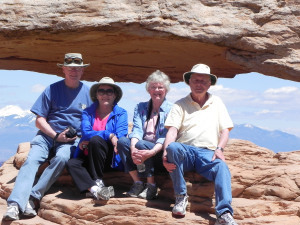
President Eisenhower reduced it in size, but President Lyndon Johnson increased it again. In 1971, President Nixon signed a bill making it a national park. In 1998, it was increased in size in order to bring in Lost Spring Canyon. Even so, at 76,519 acres, it is relatively small in area.
Nevertheless, people throng here from all over the world. Few indeed see all 2,000 arches, but most see the park's two crown jewels: the iconic Delicate Arch, which park officials claim to be "the best-known arch in the world"—it even graces Utah's license plates. Probably only Monument Valley's Rainbow Bridge could challenge its worldwide preeminence. The other must-see is one of the world's longest natural spans at 306 feet, Landscape Arch. But since it is only eleven feet wide (12 feet at its center), arch buffs fear for its future. For they remember that Wall Arch had stood here for thousands of years: in fact it was already curving gracefully when the Egyptian pyramids were under construction over 4,000 years ago. Yet, on Aug 5, 2008, Wall Arch simply collapsed. Then there's Skyline Arch. Until 1940, a huge boulder blocked half its opening, then suddenly, after no one knows how many years of slow erosion undermining the boulder's support, gravity won: the giant stone tumbled out of the arch, and Skyline Arch instantaneously nearly doubled in size. 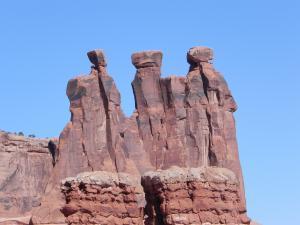
Other favorites tourists search out include The Three Gossips, Double O Arch and the Fins in Devil's Garden, Double Arch in the Windows section, The Three Penguins, Surprise Arch, The Eye of the Whale, Balanced Rock and Chip-off-the-Old Block, Pine Tree Arch, North Window, Turret Arch, Sipapu and Kachina Bridges, Owachomo Bridge, etc.
Arches is a place to return to, again and again.
CANYONLANDS NATIONAL PARK
Nearby Canyonlands National Park, at 387,598 acres, is over four times the size of Arches. Though it is the largest national park in Utah, it is the least developed, the wildest; a landscape characterized by famed explorer John Wesley Powell as "a wilderness of rocks…with ten thousand strangely carved forms in every direction." Powell also named such popular attractions as Cataract Canyon, the Dirty Devil, and the Labryinth.
During the 1950s and 1960s uranium prospectors ran roughshod over this area. Bulldozed roads crisscrossed the landscape. But in 1964, no small thanks to Stewart Udall, President Lyndon Johnson signed legislation for the establishment of Canyonlands National Park. 
Mel White points out that while Canyonlands does have "some paved roads leading to spectacular views, most of the park is accessible only to hikers, boaters, and mountain bikers…. The positive side of this remoteness, of course, is the solitude, beauty, and adventure the park offers to intrepid visitors. Canyonlands protects one of the most unspoiled areas of the vast Colorado Plateau, a high desert region of stark rock formations, deep river-cut canyons, and sparse vegetation that receives less than 10 inches of rain in an average year. Two of the West's iconic rivers, the Colorado and the Green, come together in the center of Canyonlands National Park. Their canyons, forming a rough "Y" shape, divide the park into three land sections. Between the two arms of the "Y" is a high mesa called Island in the Sky, 1,000 feet above the surrounding landscape and more than 2,000 feet higher than the site of the rivers' confluence. To the east is The Needles, a land of tall colorful sandstone pinnacles. To the west is The Maze, reachable from the other sections only by a long, roundabout journey involving unpaved roads. Because of the remoteness of The Maze, and time needed to reach it, most visitors spend at least three days exploring it. Park rangers, with good reason, describe the rivers themselves as the fourth section of Canyonlands" (White, p. 350).
OUR OWN VISIT
We made an early start for we were foolishly attempting to see both parks in one day. Our first stop was at the Arches Visitor Center. We have learned that visiting a park's visitor center early on reduces the risk that we'll inadvertently miss must-see portions of the park. As we crested at the top of a long steep hill, there in the east were the spectacular snowcapped La Sal Mountains (Utah's second highest range). We stopped at popular sites such as Balancing Rock, Park Avenue, Three Gossips, North Window and South Window, Double Arch, and Turret Arch. This took all morning. 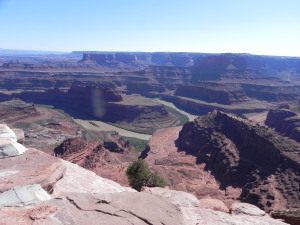
In the afternoon, we moved on over to Canyonlands. After spending some time in the Island in the Sky Visitor Center, we walked out to the dramatic-looking Mesa Arch—a kind traveler took a group photo of us there. From there, we stopped at Buck Canyon Overlook and Grand View Overlook. And then we took the long side trip out to Dead Horse Point Overlook, one of the most photographed overlooks in America. From the highest point on the Island in the Sky Mesa, you can see a hundred miles into some of the grandest scenery on the planet: the snowcapped La Sal Mountains (over 12,000 feet in elevation) to the east, the Abajo Mountain Range to the south, and the Henry Mountains to the southwest.
We were tired when we returned to our motel late that afternoon, for we'd packed a lot into one day; next time, we vowed we'd stay longer and see more within each park. 
* * * * *
Next Wednesday, we will move on to Capitol Reefs and Bryce Canyon.
* * * * *
SOURCES USED
Arches National Park (Moab, Utah: Arches National Park, 2011).
Duncan, Dayton and Ken Burns, The National Parks: America's Best Idea (New York: Alfred A. Knopf/Random House, 2009).
Johnson, David, Arches: The Story Behind the Scenery (Wickenberg, AZ: KC Publications, 2010).
Johnson, David, Canyonlands: The Story Behind the Scenery (Wickenberg, AZ: KC Publications, 2010).
The Most Scenic Drives in America (Pleasantville, New York: Reader's Digest, Inc., 1997).
Utah's Canyonlands Travel Region (Moab, Utah: Utah's Canyonlands, 2011).
Utah's National Parks and Monuments (New York: American Park Network, 2009).
White, Mel, Complete National Parks of the United States (Washington, D.C., National Geographic Society, 2009).








November 23, 2011
Next Post
DR. JOE'S BOOK OF THE MONTH CLUB
Nov. 23, 2011
SELECTION TWO
THE CHRISTMAS ANGEL
by
ABBIE FARWELL BROWN
DICKENS AND BROWN
If the truth must be told, I almost chose Dickens' Christmas Carol as our December selection, but had second thoughts because Connie and I concluded that most of you would have already read it. If it should turn out that you have not, I have a suggestion: In such a case, since both The Christmas Carol and The Christmas Angel are quick reads, I suggest that you read Dickens' great classic first, for all modern Christmas stories graft on to Christmas Carol.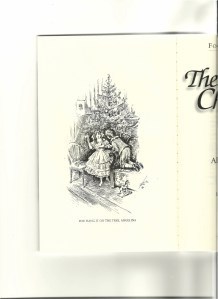
I was privileged to partner with Focus on the Family and Tyndale House in twelve classic books: Louisa May Alcott's Little Women (1997) and Little Men (1999); Daniel Defoe's Robinson Crusoe (1997), and The Farther Adventures of Robinson Crusoe (1999); Lew Wallace's Ben-Hur (1997), Henryk Sienkiewicz's Quo Vadis (2000); Grace Richmond's The Twenty-fourth of June (1999); Gene Stratton Porter's Freckles (1999); Lucy Maud Montgomery's Anne of Green Gables (1999); Abbie Farwell Brown's The Christmas Angel (1999); and Charles Dickens' A Christmas Carol 1997) and David Copperfield (1999). For each of these I wrote a modest biography of the author (averaging 60 – 80 pages in length) as well as discussion questions placed at the back of the book for individual readers, parents, teachers, and homeschoolers. And we featured the oldest or best set of illustrations we could find.
All these books have long since gone out of print, however, we still have sale copies available (new condition) for almost all of them should you be interested in purchasing them from us. Since I'm hoping that you'll either re-read or read for the first time The Christmas Carol, I'm featuring part of my introduction/biography: 'Scrooge at the Crossroads."
I cannot remember when I first heard it read . . . nor when I first read it . . . nor when I first experienced it on film . . . nor even when it first engulfed me as live drama. . . . I only know that looking back through life, somehow — I know not how — Christmas Carol was always there.
In the annals of literature there is nothing like it. Certainly there was nothing like it before Dickens wrote it in 1843 — since then, many have tried to imitate it. But the great original still stands, alone and inviolate — the Rock.
Can Christmas possibly be Christmas without it? Many there be who would answer in the negative: somehow, to conclude even one Christmas season without re-experiencing the story would be to leave that year incomplete.
In the century and a half since it was published, we have come to take it for granted: we just accept it as if it had always been with us: like Wise Men, creches, and holly. What would the world, after all, be like without Scrooge, Marley, the Cratchits, the Three Ghosts, Bah! Humbug! and Tiny Tim? Well, in the year of our Lord, 1842 — none of those yet existed.
So what was 1843 like for Charles Dickens? Simply and succinctly put: not good. It was about time for it to be "not good." Let's step back in time — and I'll explain.
As we can see in the bio, Dickens endured a tough childhood — a mighty tough childhood. Then, at the age of 25, he was catapulted to the top of his world. It is always dangerous to soar too high too young: it usually results in a strong case of King of the Mountain hubris — unless the 25-year-old is strong and wise beyond his years; unless he realizes, with Nebuchadnezzar, how quickly the God who giveth can become the God who taketh away; even more importantly, unless he realizes that, in life, nature ‑‑, and apparently, God ‑‑ abhors long plateaus. In other words, today's Success is already unrealizingly sowing the seeds of its own destruction. This was true with Dickens. He had assumed, as had that great Babylonian king before him, that he had become king and great all by himself ‑‑ by the sheer brilliance of his mind and force of his will. Both of which he had an oversupply of.
Perhaps a baseball analogy would help. In 1836, he stepped up to the plate, and hit Boz out of the park. Next, he hit Pickwick out of the park. Then Oliver Twist, then Nickelby, then The Old Curiosity Shop, then Barnaby Rudge, which just cleared the outer wall. Then came his ill-fated trip to America, and when his bat made contact with American Notes, he only hit a bloop single, not even realizing that he now had a hairline crack in the bat. That was followed by Martin Chuzzlewit ‑‑ and with it, he broke his bat.
For the first time in seven years, he was in trouble. He had mistakenly assumed that, being King of the Hill, he could say anything he darn well pleased. That he could travel to the late great colony of America and noblesse oblige himself all over the place. Since Americans were too cheap to pay him his due royalties, he could just tell them where to go. To put his condition in modern vernacular, he had an attitude problem. Even his countrymen felt, this time, that he had gone too far.
The result: the golden faucet ‑‑ that had gushed its riches upon him for almost seven years ‑‑, now slowed its flow so much he wondered if perhaps his well was going dry. Even worse, what if it was dry? What if people would no longer buy his books?
Dickens was never much of a humble man: he knew to a penny the value of his gifts. Or had known prior to 1842. Now, he didn't know any more.
Well, what could he write that would improve his fortunes, and help bring back his fickle audience? Something he could write quickly, not just another two-year book serialization. So the idea for Christmas Carol came to him (see bio). For a month and a half he totally immersed himself in the world of Scrooge. In the process, he gradually became aware that, somewhere along the way, he had become a Scrooge himself: had felt himself so secure in his gifts that he no longer needed other people, that he no longer needed to really care (not just abstractly, but one-on-one) about human need.
In the course of writing the story of Scrooge, Dickens was able to pull himself back from the brink, to realize his need of others. He began to wonder if he any longer knew ‑‑ or if he ever had ‑‑ who he really was. Could he even know without going backwards in time?
The answers to those questions were a long time in coming, but A Christmas Carol was the first step, the four other Christmas books represent additional steps, but the biggest steps were Dombey and Son, David Copperfield, A Tale of Two Cities, Great Expectations, and The Mystery of Edwin Drood.
Yet something else happened during the writing of the little book: he learned a great deal about the difference between writing a lean cohesive book (written all at once) and writing the usually episodic, rambly, serialization book.
As a result of this no man's land between the hubris of his youth and the social conscience of his maturity, he was able to make it the rest of the way through his life without ever again seriously daring hubris. He was able to find out things about himself that stripped away some of his teflonish pride. And sorrow would rock him on his heels again and again.
So it came to pass that in the last quarter of his life, in his 450 public readings (for fifteen long years, having an average of one public reading performance every twelve days), the story of Scrooge became as indispensable as singing the national anthem at a big league baseball game ‑‑ unthinkable to close without it. And as his life drew to a close, a higher and higher percentage of each evening performance was devoted to Christmas Carol and its lesson of agape love.
It is no hyperbole to say that without this one little book, the life of Charles Dickens most likely would have been a very different story. In a very real sense, then, we may validly say that the characters ‑‑ children, if you will ‑‑ conceived by this author ended up by taking him on a long journey . . . that would take the rest of his life.
And it is our privilege to be invited along.
Welcome to the timeless world of Christmas Carol.
ABBIE FARWELL BROWN AND
THE CHRISTMAS ANGEL
I have always loved Christmas stories — especially the heart-tugging kind. And, let's face it, sentiment and Christmas belong together. Of all the seasons of the year, the heart is openest to love, empathy, kindness, forgiveness, generosity, and change . . . at Christmas.
Thousands of authors have written stories about Christmas, but sadly, most of them are shallow, sterile, and un-moving. These stories may be technically brilliant, but if they fail to engage the heart, I view them as failures.
Only a few have written "great" Christmas stories, and even fewer have written "great" Christmas books (usually novelette length rather than full book length, as Christmas books are rarely very long). And of those few special Christmas books which percolate to the top, very very few manage to stay there, but gradually, over time, sink down into that vast subterranean sea of forgotten books. To stay alive, season after season, generation after generation, presupposes a magical ingredient no critic-scientist has ever been able to isolate. Just think about the ones that come to mind: The Christmas Carol, Miracle on 34th Street, Its a Wonderful Life, The Other Wise Man . . . , and, with these four, we begin to sputter and qualify. There are many others that come to mind, but none of them has been able to stay in the top ranks of Christmas Best Sellers. In recent years, The Best Christmas Pageant Ever by Barbara Robinson (1972) and Richard Paul Evans' The Christmas Box (1993) have so far evidenced staying power, but only time will reveal whether they will stay there, for it is comparatively easy to stay alive for ten, twenty, even thirty years ‑‑, it is much much harder to remain vibrantly alive 40, 50, 60, 70, 80 years or more.
But, none of this precludes comebacks. Literature and public taste are, after all, cyclical, thus even during authors' lifetimes, reputations roll along on roller-coasters, undulating up and down as public tastes and demands change. No one remains hot forever. Along this serpentine track of survivors rumble authors such as Dickens, Dostoevsky, Hugo, Cooper, Scott, Stevenson, the Brontes, Twain, Cervantes, Tolstoy, Alcott, Shakespeare, Carroll, Chaucer, Defoe, Dante, Dumas, Eliot, Kipling, and Thoreau — these never go out of vogue.
Once past the immortals, we move into a much more fluid field. Depending on many factors, recoveries and resurrections continue to take place. Usually because certain works brazenly dig into our memories and impudently refuse to leave. Which brings us to Abbie Farwell Brown.
It was some years ago when I first "met" her. My wife and I were wandering around New England at the height of fall colors. Ah, autumn in New England! There are few experiences in life to match it. Among those few are New England used bookstores. Well, it was in one of these that Connie discovered an old book — and short — with the intriguing title of The Christmas Angel. She brought it over to me and asked if I was familiar with it or with the author. I was not, but on the strength of the wonderful woodcut illustrations, we bought it. Upon our return home, I unpacked it, then sat down to read it — and LOVED it. Such velcro sticking power does it have that it has pummeled me until I am black and blue from its demanding to be brought back to the top, where it keeps telling me it belongs! It was there once, and liked it, but, through no fault of its own, readers who loved it died off, so it began its gradual descent into that ultimate oblivion.
So here it is, if for no other reason than to rescue my battered body from its continuous pummeling. I don't often creep out far enough on limbs to risk getting sawed off, but I shall make an exception for The Christmas Angel. I shall be really surprised if it does not claw its way back to the top — and stay there, this time. It has all the enduring qualities that has kept The Christmas Carol up there for over a century and a half — in fact, one manuscript reader told me, about a week ago, that she even prefers it over The Christmas Carol. It is one of those rarities: a book that should be loved equally by all generations — from small children to senior citizens. I can see it being filmed; and I can see it becoming a Christmas tradition: unthinkable to get through a Christmas season without reading it out loud to the family once again.
Since the story is divided into 15 short chapters, it would lend itself to being spread out during the Advent or the Twelve days of Christmas. Having said that, I'll prophesy that pressure to read on by the listeners might make a proposed time table difficult to stick with.
And, unquestionably, the Reginald Birch illustrations add a very special dimension to the book.
When Christ wished to hammer home a point, He told a story, a parable, an allegory — in fact, biblical writers tell us He never spoke without them. This is just such a story. But, coupled with that is something else: it is one of the most memorable and poignant Angel stories I have ever read. And it is amazing how many people today are rediscovering Angel stories!
It has to do with Miss Terry — bitter, cold, bigoted, and unforgiving. As was true with Dickens' Scrooge, in her life virtually all sentiment, caring, and love had been discarded, then trampled on, in her morose journey through the years. And now, at Christmas, but one tie to her past remains, one key that might unlock her cell block of isolation: her childhood box of toys.
She determines to burn them, — every last one.
* * * * *
It is my personal conviction that reading both books this Christmas season will result in one of the richest Christmas seasons you have ever known. And it will amaze me if you don't end up loving The Christmas Angel at least as much as The Christmas Carol.
In my introduction/biography for The Christmas Angel I piece together Brown's fascinating life story and list all her books and short stories. I'm guessing many of you will wish to track down and purchase her other books as well as this one.
Be sure and journal each time you read from these books.
At the back of my edition are seven pages of questions to deepen your understanding. Such as these:
Chapter One: "Alone on Christmas Eve" – What is the impact of that line? Why is it harder to be alone on Christmas Eve than at other times? Or is it?"
Chapter Four: "Why is it, do you think, that so few toys survive intact? Are they deliberately mistreated, or does it just happen"
Chapter Six: "Why did Miss Terry rescue the Christmas angel from the muddy street, and why did she find it impossible to toss it into the fire as she had so many other toys?"
Chapter Nine: "Why is it, do you think, that toys have greater reality to children than they do to adults? How is that borne out in this chapter?"
Chapter Fourteen: "How do Angelina's Christmas angel and her guardian angel blur together?"
LAST SUGGESTIONS RE WRIGHT'S CALLING OF DAN MATTHEWS
More and more people keep expressing interest in The Book Club. When you notify us that you wish to join, please email that information to us so we can add you to the roster. If you feel uncomfortable posting your mailing address on the web, just drop it in the mail to me at P.O. Box 1246, Conifer, CO 80433. Send me your name, interests, reading preferences, and other items that will help me chart the direction of The Book Club.
After securing a copy of each month's book, be sure and journal each time you read from the book.
Following are some observations and suggestions re your reading our November selection: Harold Bell Wright's The Calling of Dan Matthews:
1. I first read it when I was seventeen. Why do you think it had such a powerful impact on me? (On others as well?)
2. How is it different from other religion-based novels you've read?
3. Wright wrote three Social Gospel novels. Look up the term, then respond in terms of how the book incorporates the movement's key elements. In other words, Christ, in His life on this earth, was not at all into doctrine or creeds, but rather into selfless service for others. So, did Wright pull it off?
4. Did reading this book have an impact on you personally? In what way?
5. Did reading the book make you want to read more Wright books?
SECURING DECEMBER'S BOOKS
You will have no trouble finding a copy of Dickens The Christmas Carol, for it is one of the best-selling books of the nineteenth and twentieth centuries. But if you'd like to order my Focus/Tyndale edition, just write me at Box 1246, Conifer, CO 80433, or send me an email at "mountainauthor@gmail.com." Should you wish me to inscribe any copies, just let me know—there will be no charge for that. The Christmas Angel is likely to be more difficult to secure, but again, I can supply you with a copy.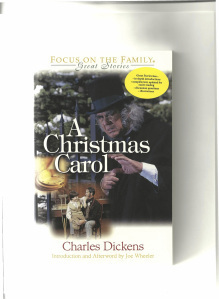
PRICE: $16.99 each. However, if you alert me to your being a member of our book club, you can reduce it to $14.00 each. If you purchase both books, I'll reduce the price to $25.00 total. Shipping will come to $6.00 extra.
I'll need your full name and mailing address. Checks are fine. So is PAYPAL. For further information, access our website at
* * * * *
Next Wednesday, we'll journey to Arches and Canyonlands National Parks.








Joe L. Wheeler's Blog
- Joe L. Wheeler's profile
- 36 followers


